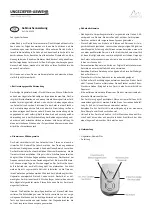
YSI 5200A
215
YSI 5200A
214
1. Soak the sensor for 30-60 minutes in one molar (1 M) hydrochloric acid
(HCl). This reagent can be purchased from most chemical supply com-
panies. Be sure to follow the safety instructions included with the acid.
2. GENTLY clean the glass bulb and platinum button by rubbing with a cot-
ton swab soaked in the acid.
3. Rinse the sensor in clean water, wipe with a cotton swab saturated with
clean water, and then re-rinse with clean water. To be certain that all traces
of the acid are removed from the sensor crevices, soak the sensor in clean
tap water for about an hour with occasional stirring.
Note - If biological contamination of the reference junction is suspected or if good
response is not restored by the above procedures, perform the following additional
cleaning step:
1. Soak the sensor for approximately 1 hour in a 1 to 1 dilution of commer-
cially available chlorine bleach.
2. Rinse the sensor with clean water and then soak for at least 1 hour in clean
tap water with occasional stirring to remove residual bleach from the
junction. (If possible, soak the sensor for a period of time longer than 1
hour in order to be certain that all traces of chlorine bleach are removed.)
Then, re-rinse the sensor with clean water and retest.
Temperature/Conductivity Sensor Cleaning
The single most important requirement for accurate and reproducible readings in
conductivity measurement is a clean sensor. A dirty sensor will change the conduc-
tivity of a solution by contaminating it. The small, round cleaning brush included
in the YSI 5511 Maintenance Kit is ideal for cleaning the conductivity sensor.
To clean the conductivity cell:
1. Dip the brush in clean water and insert it into each hole 15-20 times.
2. Rinse the cell thoroughly in deionized or clean tap water.
In the event that deposits have formed on the electrodes, perform the following
additional procedure:
1. Use a mild detergent solution in combination with the brush. Dip the
brush in the solution and insert it into each hole 15-20 times.
2. Rinse the cell thoroughly in deionized or clean tap water.
3. After cleaning, check the response and accuracy of the conductivity cell
with a calibration standard.
If this procedure is unsuccessful or if sensor performance is impaired, it may be
necessary to return the sensor to a YSI authorized service center for service.
Maintenance
The temperature portion of the sensor requires no maintenance.
Recommended Cleaning of the 5200A and Accesso-
ries
Clean the 5200A monitor and accessories as needed. Dampen a cloth with warm
water and wipe the outside of the unit. Use water with mild detergent. Do not use
acid-based, alkali-based, or other organic solvent-based solvents (e.g., acetone,
alcohol, etc.).
Storage
Proper storage between periods of usage will not only extend the life of the sensors,
but will also ensure that the unit will be ready to use as quickly as possible for your
next application.
Short Term Storage
Short term storage is defined as a period of time < 30 days. For short term storage,
it is important to keep the sensors in a moist environment without actually immers-
ing them in liquid. Immersing the sensors could cause some to drift or result in a
shorter sensor lifetime.
For short term storage, place approximately ½ inch of tap water in the calibration/
storage cup and install the cup over the sensors on the cable. The use of a moist
sponge instead of a ½ inch of tap water is also acceptable. The calibration/storage
cup should be sealed to prevent evaporation.
Note - If using the 5562 probe/cable, ensure that an o-ring is installed in the o-ring
groove on the threaded end of the probe assembly.
CAUTION: The water level has to be low enough so that none of the sensors are
actually immersed in water. Check the calibration/storage cup periodically to
ensure it is still moist.
Long Term Storage
Long term storage is defined as a period of time > 30 days.
Maintenance
















































